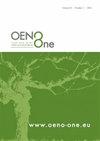How to better estimate bunch number at vineyard level?
IF 2.2
3区 农林科学
Q3 FOOD SCIENCE & TECHNOLOGY
引用次数: 1
Abstract
Despite the extensive use of sampling to estimate the average number of grape bunches per vine, there is no clearly established sampling protocol that can be used as a reference when performing these estimations. Each practitioner therefore has their own sampling protocol. This study characterised the effect of differences between sampling protocols in terms of estimation errors. The goal was to identify the most efficient practices that will improve the early estimation of an important yield component: average bunch number. First, the appropriateness of including non-productive vines (i.e., dead and missing vines) in the sampling protocol was tested; the objective was to determine whether it is relevant to estimate two yield components simultaneously. Second, sampling protocols with sampling sites of varying size were compared to determine how the spatial distribution of observations and potential spatial autocorrelation affect estimation error. Third, a new confidence interval for estimation error was determined to express expected error as a percentage. It aimed at designing a new tool for finding the best sample size in an operational context. Tests were performed on two vineyards in the South of France, in which the number of bunches per vine had been exhaustively determined on all the plants before flowering. The results show that the simultaneous estimation of number of bunches and proportion of dead and missing vines increased the estimation errors by a factor of 2. Despite the low spatial autocorrelation of bunch number, the results show that the observation must be spread across at least 2 or 3 sampling sites to reduce estimation errors. Finally, the confidence intervals expressed as a percentage were validated and used to define an adequate sample size based on a compromise between the expected precision and the variability observed in the first measurements.如何更好地估计葡萄园级别的葡萄串数量?
尽管广泛使用采样来估计每株葡萄的平均葡萄串数量,但在进行这些估计时,没有明确制定的采样协议可作为参考。因此,每个从业者都有自己的采样方案。这项研究从估计误差的角度描述了采样协议之间差异的影响。目标是确定最有效的实践,以改进对一个重要产量组成部分的早期估计:平均束数。首先,测试了将非生产性葡萄藤(即死亡和缺失的葡萄藤)纳入采样方案的适当性;目的是确定同时估计两个产量成分是否相关。其次,比较了具有不同大小采样点的采样协议,以确定观测的空间分布和潜在的空间自相关如何影响估计误差。第三,确定了一个新的估计误差置信区间,将预期误差表示为百分比。它旨在设计一种新的工具,以便在操作环境中找到最佳样本量。在法国南部的两个葡萄园进行了测试,在开花前,对所有植物的每株葡萄的束数进行了详尽的测定。结果表明,同时估计葡萄串的数量和死亡葡萄藤和缺失葡萄藤的比例会使估计误差增加2倍。尽管束数的空间自相关较低,但结果表明,观测必须分布在至少2或3个采样点,以减少估计误差。最后,验证了以百分比表示的置信区间,并根据第一次测量中观察到的预期精度和变异性之间的折衷,使用置信区间来定义适当的样本量。
本文章由计算机程序翻译,如有差异,请以英文原文为准。
求助全文
约1分钟内获得全文
求助全文
来源期刊

OENO One
Agricultural and Biological Sciences-Food Science
CiteScore
4.40
自引率
13.80%
发文量
85
审稿时长
13 weeks
期刊介绍:
OENO One is a peer-reviewed journal that publishes original research, reviews, mini-reviews, short communications, perspectives and spotlights in the areas of viticulture, grapevine physiology, genomics and genetics, oenology, winemaking technology and processes, wine chemistry and quality, analytical chemistry, microbiology, sensory and consumer sciences, safety and health. OENO One belongs to the International Viticulture and Enology Society - IVES, an academic association dedicated to viticulture and enology.
 求助内容:
求助内容: 应助结果提醒方式:
应助结果提醒方式:


